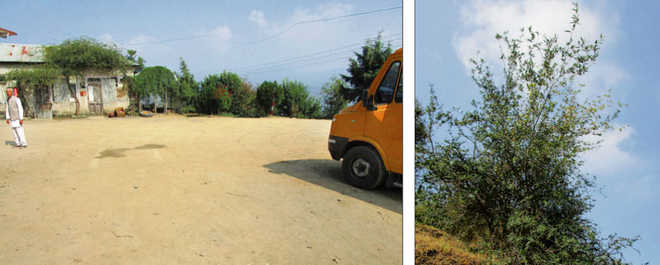‘Anokhi Dali’ Mela & legend of Hrinyakashyap
Shriniwas Joshi
Recently, 91 persons of varied age undertook a 5-km nature walk from Jubbar Hatti (near Shimla Airport) to Dounti, a village at Kahla panchayat in Kandaghat block of Solan district, under the aegis of the Shimla Amateur Garden and Environment Society (SAGES). The society conducts two nature walks a year — the one during the summer is done at places higher than Shimla and during the winter at a place warmer than Shimla. It is not only a walk amidst the beauty of nature but also an educational trip because eminent botanists such as Subhash Gupta, Mela Ram Sharma and SL Kashyap inform the walkers about the flora of the area. This time, students of two schools — Laureate and Auckland (Boys) — had also joined the party. They confessed that they were ignorant about the bounty of nature earlier but returned wiser.
Among many plants, shrubs and trees, there is a specific tree found there called ‘Anokhi Dali’ (unique tree) in local dialect. Its common name is brown olive, wild olive, and Indian olive while in Himachal it is known as ‘Kahu’ or ‘Kan’ or ‘Kao’. Its botanical name is ‘Olea cuspidata’. It is an evergreen tree usually growing 2 m to 10 m tall; occasionally it touches even 15 m. Its leaves, 6 cm to 10 cm long, are oppositely arranged. The leaves have glossy dark green upper surface and greenish or yellowish-brown lower surface. It is found in western Himalayas, at altitudes from 600 m to 2,800 m and in Africa and West Asia also. Its one quality that villagers found helpful was that it burns green and helps them in lighting fire. When it is also found in other parts of the state, then why is it called ‘Anokhi Dali’ here?
It was first seen, as a huge tree, long back at the place where the airport exists today. The tree was the abode for Narsingh avatar or the fourth Dashavatara of Lord Vishnu. In this avatar, Lord Vishnu had appeared in the form of half lion and half man and killed Hiranyakashyap, father of Prahlaad. There was a pujari, who used to propitiate the idol of Narsingh there. One day, a thunderstorm struck the area and the tree fell down at noon. Narsingh was settled in a temple. One night, he appeared in the dreams of the pujari and directed him to arrange a mela in the honour of the tree, ‘Anokhi Dali’. The pujari arranged the mela for the first time there 116 years ago. Since then, it is being celebrated every year on the ‘Pratipada’ and ‘Dooj’ after Diwali. This year, the days fall on November 13 and 14. The mela ground was converted into a runway for the airport constructed there in 1982. The mela had to be shifted to nearby Halti village. However, the government took over the land where the mela was being organised for the construction of residences for Central Industrial Security Force personnel. The mela was shifted to the ground of Mount Shivalik Public School where it is being organised continuously for the past several years.
As Narsingh directed the pujari in his dreams, ‘Thoda’ has to be an essential item of the mela. ‘Thoda’, the impressive martial art from Himachal Pradesh, relies on one’s archery prowess where bows and arrows are used. The name ‘Thoda’ has been derived from the round piece of wood fixed to the head of the arrow used to blunt its wounding potential. The archers are divided into two parties — one party is called ‘Shaathi’ and the other ‘Paashi’ — supposed to be representing Kauravas and Pandavas, respectively. The target in this game is the legion of the leg, below the knee, where the opponents should aim their arrows.
The two parties first appease the battleground and they call “Chinchuri jaiee phoole meri jubriye” (Battleground, bloom like Chinchuri shrub). Chinchuri is a shrub that blooms with beautiful flowers. The game begins with the attack on the legs of the opponents, who kick their legs to and fro with brisk movements to thwart the accurate aims of their adversaries. Lightning movements and agility are the sole method of defence. The game is a happy blend of sports and culture played amidst the sounds of war-like music.
The ‘Anokhi Dali’ Mela and Chinchuri’s blooming appear to be associated with environment and tree protection. The mela is the most penetrating preacher of the ‘grow more trees’ campaign.
Flower-lovers Bharati Sharma, Principal of Mount Shivalik Public School, and her husband Mahinder Sharma are locals, and are proud possessors of a poly-house having carnations in abundance. They offer their school ground for holding the ‘Anokhi Dali’ Mela every year. They say that the mela still attracts syrupy jalebi-makers and bangle-sellers but among the youth the zest, as was visible in bygone days, has melted.
Tailpiece
“If I were a tree, I would have no reason to love a human.” — Maggie Stiefvater










